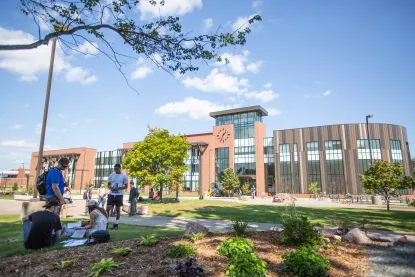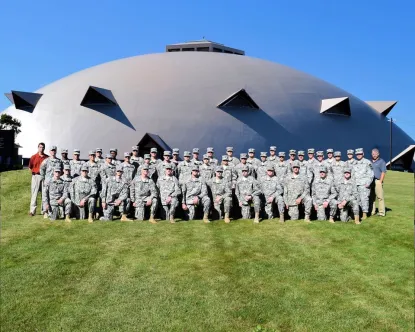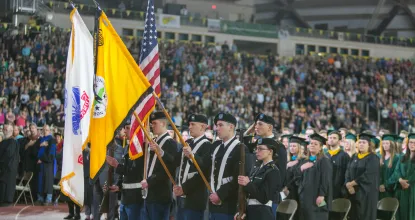
Military Science at NMU
Military Science is the academic department for both students participating in the Minor of Military Science and Reserve Officer Training Corps (ROTC) Cadets seeking commissions as officers in the U.S. Army, Army Reserves or National Guard. If you want to learn about leadership principles that will make you successful in the military or the private and public sectors, you have come to the right place.

Open to all NMU Students
All NMU students are welcome to participate in ROTC and there is no military obligation in taking a single ROTC class or in completing the minor in Military Science and Leadership. Students may add, drop, or withdraw from military science courses as in any other academic program. Only students who earn scholarships, tuition assistance, or who elect to contract to commission into a component of the U.S. Army incur service obligations after graduation. Students who elect to participate in the commissioning program become ROTC Cadets and are full-fledged members of the Wildcat Battalion. It is up to each student to decide how to participate in Military Science and/or ROTC.

Premier Leadership Training
Army ROTC is the largest merit-based scholarship and tuition assistance program in the country and is the premier leadership training program on college campuses across the country. The program emphasizes developing leadership, professional ethics, problem-solving skills, self-confidence, and developing an ethos of health and physical fitness. Military science complements any student's major by providing hands-on leadership experience packaged in a valuable academic minor. Military Science leadership training is also recognized by the NMU Superior Edge Program as meeting the Leadership component.

Wildcat Battalion Alumni
We are interested in hearing all about what our previous cadets are up to now. Stay connected so that we can share your exciting stories with the current and future cadets of the Wildcat Battalion.

Wildcat Battalion History
The concept of the Reserve Officer Training Corps (ROTC) in the United States began with the Morrill Act of 1862 which established the land-grant colleges. The federal government established the requirement for the inclusion of military tactics as part of the curriculum, forming what became known as ROTC.

Cadet Command History
The Army Reserve Officers' Training Corps (ROTC) began with President Wilson signing the National Defense Act of 1916. Although military training had been taking place in civilian colleges and universities as early as 1819, the signing of the National Defense Act brought this training under a single, federally-controlled entity: The Reserve Officers' Training Corps.

More Information
Wildcat Battalion History
The concept of the Reserve Officer Training Corps (ROTC) in the United States began with the Morrill Act of 1862 which established the land-grant colleges. The federal government established the requirement for the inclusion of military tactics as part of the curriculum, forming what became known as ROTC. At many universities, participation in ROTC was compulsory for all male underclassmen and these ROTC graduates would form the Officer Corps in any future conflicts. ROTC expanded in the lead up to World War I and again prior to World War II. After the great wars, ROTC began to shift to a pre-commissioning training program for student seeking commissions in the Armed Forces of the United States.
In 1948, the State Board of Education authorized the four teachers' colleges in Michigan to request and install ROTC on their campuses. However, NMU’s application was not accepted. After 1952, due to the expense of expanding ROTC programs and manpower issues, the Secretary of the Army instructed the U.S. Army not to increase the program beyond established units. In 1965, President Edgar Harden expressed NMU’s continued interest in being considered as a host university should the ROTC program be expanded. However, it was not until 1967 that Northern was invited to file a formal application for a senior ROTC unit.
Ironically, NMU’s request to establish an ROTC unit coincided with the growing unpopularity of the Vietnam War. Nationwide campus protests, mostly concerning the war and military conscription, sometimes focused on the ROTC units on campuses. In keeping with the sentiment of the times, there were debates over the establishment of ROTC at NMU. Many students, faculty, and administrators objected to the program as they believed the program would be compulsory similar to the ongoing military draft. However, by late summer, objections to the establishment of the ROTC were overcome by the knowledge that ROTC was a voluntary program. In November 1968, Northern was notified that its application had been accepted and meetings were held to discuss the implementation of this program.
The Department of the Army began assigning officers to the detachment in February of 1969. On April 17, 1969, NMU's Department of Military Science was established. In keeping with long standing tradition, NMU’s ROTC Cadets incorporated the host university’s athletic mascot name becoming the Wildcat Battalion of U.S. Army ROTC. Housed initially in the local National Guard Armory, the first classes met in September with an enrollment of 53 students. In the spring of 1971, the Department commissioned its first two lieutenants. In 1973, ROTC was officially opened to women and 13 female students enrolled in the program. From 1976 to 1982, NMU ROTC also hosted Lake Superior State's ROTC program.
By 1977, with the establishment of the “All Volunteer Force” within the Department of Defense, the ROTC Program became a merit-based scholarship and tuition assistance program for students desiring to become commissioned officers. U.S. Army ROTC has grown to become the largest leadership development and merit-based scholarship program in the country.
Today, NMU’s Wildcat Battalion of U. S. Army ROTC continues to offer a wide variety of scholarships and tuition assistance to students seeking to serve on active duty in the U.S. Army or in the U.S. Army Reserve and National Guard. The Military Science department also offers a Minor of Military Science and Leadership for all students as a compliment to any academic major.
Cadet Command History
The Army Reserve Officers' Training Corps (ROTC) began with President Wilson signing the National Defense Act of 1916. Although military training had been taking place in civilian colleges and universities as early as 1819, the signing of the National Defense Act brought this training under a single, federally-controlled entity: The Reserve Officers' Training Corps.
Army ROTC is the largest officer-producing organization with the American military, having commissioned more than half a million second lieutenants since its inception.
Women have been an integral part of the Army ROTC since 1972-73. The first group of females from ROTC were commissioned in 1975-76. Today, women constitute 20 percent of the Corps of Cadets and more that 15 percent of each commissioning cohort.
In April 1986, the U.S. Army Cadet Command was formed. With its headquarters at Fort Monroe, Virginia, Cadet Command assumed responsibility for more than 400 senior ROTC units, four regional headquarters, and the Junior ROTC with programs in more than 800 high schools. Cadet Command transformed the ROTC from a decentralized organization turning out a heterogeneous group of junior officers into a centralized command producing lieutenants of high and uniform quality. An improved command and control apparatus, an intensification and standardization of training, and improvements in leadership assessment and development helped produce this transformation of pre-commissioning preparation.
Today, Army ROTC has a total of 272 programs located at colleges and universities throughout the 50 states, the District of Columbia, Puerto Rico and Guam, with an enrollment of more than 25,000. It produces over 60 percent of the second lieutenants who join the active Army, the Army National Guard and the U.S. Army Reserve. More than 40 percent of current active duty Army General Officers were commissioned through the ROTC. Of even greater importance is that ROTC trained and educated officers bring a hybrid vigor to our officer corps by drawing on the strength and variety of our social fabric. Cadet Command accomplishes this by combining the character-building aspects of a diverse, self-disciplined civilian education with tough, centralized leader development training. This process forges a broad-gauged officer who manifests the strength and diversity of the society from which he or she is drawn as well as the quality of strong officer leadership.
Cadet Command is also responsible for the Junior ROTC. Today, there are over 1600 JROTC units and over 274,000 cadets. Both totals are historic highs. JROTC has an enormously positive effect on our youth helping young people from across the socio-economic spectrum. Cadets graduate from high school at a higher rate, have higher GPAs, and have less incidents of indiscipline than their classmates. Although the JROTC is a citizenship program, not a recruiting tool, JROTC graduates enter the armed forces at a much higher rate than their peers. The Junior ROTC is a great program, benefiting the Army, the nation, local communities, and above all, the JROTC cadets themselves.
